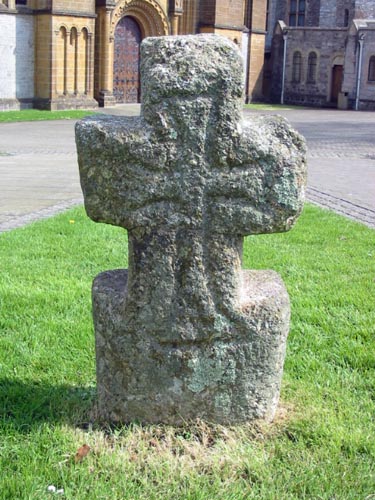
 |
 Location:
In the centre of a lawn, to
the right on entry to the grounds from the car park and and a few yards to
the East of the ex Moorshop Cross. Location:
In the centre of a lawn, to
the right on entry to the grounds from the car park and and a few yards to
the East of the ex Moorshop Cross.O/S Grid Ref: SX/74082/67426 Longitude/Latitude (Degrees+/-): -3.77657/50.49306 Map location: Click here to view map. Purpose: It was probably used in its original position as a waymarker. Size: 3 feet 3 inches (1.00 metres) tall. 1 foot 9 inches (0.53 metres) across the arms. The shaft is 10 inches (0.25 metres) deep. Information: This is a most unusually shaped cross, especially as the shaft has not been trimmed to a uniform width for the whole of its length. For the bottom 19 inches (0.45 m) the shaft extends to almost the full width of the arms. Whereas, the upper portion of the shaft is only about half the width of the arms. A Maltese Cross is inscribed on both faces, of the following measurements:
Buckfast Abbey was originally founded in 1018 on a site which was originally known as ‘Bulfestra’. The Abbey stood until 1539, when it was destroyed under the suppression of the Catholic faith during the reign of Henry VIII. It is now home to a Roman Catholic community of Benedictine Monks, who were expelled from France and took up residence here in 1882. The Abbey church was rebuilt by the monks themselves, on the foundations of the original church. The Abbey is run as a self-sufficient business and its activities include tourism, stained-glass window making and beekeeping, with the sale of its honey. However, the most well-known product must be the Buckfast Tonic Wine, which seems to go down particularly well in Scotland for some reason! The Abbey now receives almost half a million visitors a year to view its splendid church and grounds. |